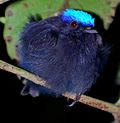Taxonomy
The genus Lepidothrix was introduced by the French naturalist Charles Lucien Bonaparte in 1854. [5] The type species was subsequently designated as the blue-capped manakin. [6] The name Lepidothrix combines the Ancient Greek words λεπις lepis, λεπιδος lepidos "scale, flake" and θριξ thrix, τριχος trikhos "hair". [7] A new genus name Neolepidothrix, was proposed in 2009 due to a suggestion that it was a junior homonym of the extinct silverfish Lepidotrix , however it was later shown that the original spelling of the silverfish genus was not same, so therefore the genera were not homonymous. [8]
The genus contains nine species: [9]
| Image | Scientific name | Common name | Distribution |
|---|
 | Lepidothrix velutina | Velvety manakin | Colombia, Costa Rica, Ecuador, and Panama |
 | Lepidothrix coronata | Blue-capped manakin | Bolivia, Brazil, Colombia, Ecuador, Peru, and Venezuela |
| Lepidothrix suavissima | Orange-bellied manakin | southern Venezuela, far northern Brazil, and central Guyana |
 | Lepidothrix serena | White-fronted manakin | Surname and French Guiana |
 | Lepidothrix iris | Opal-crowned manakin | Brazil |
 | Lepidothrix vilasboasi | Golden-crowned manakin | Brazil |
 | Lepidothrix nattereri | Snow-capped manakin | Amazon Basin of Brazil and far north-eastern Bolivia |
 | Lepidothrix isidorei | Blue-rumped manakin | Colombia, Ecuador, and Peru |
| Lepidothrix coeruleocapilla | Cerulean-capped manakin | Peru |
|
This page is based on this
Wikipedia article Text is available under the
CC BY-SA 4.0 license; additional terms may apply.
Images, videos and audio are available under their respective licenses.








